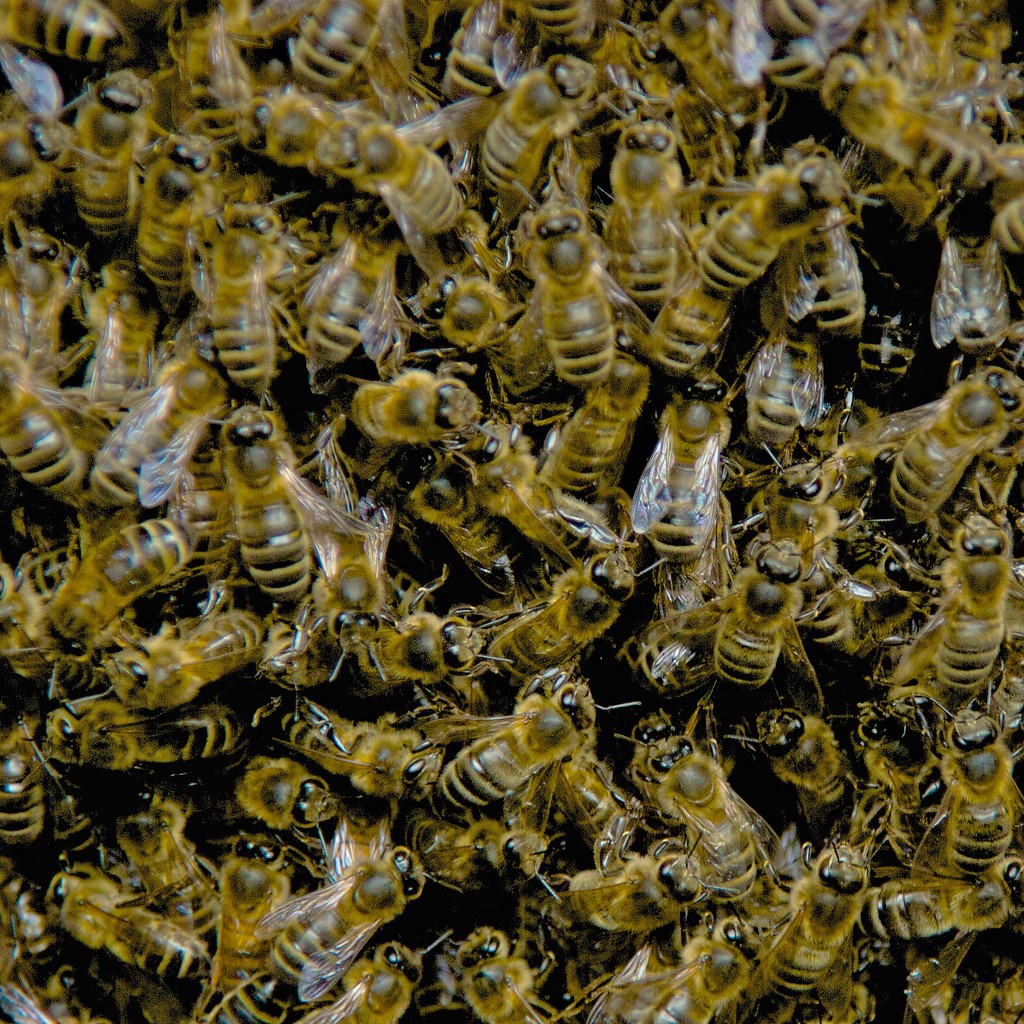Why Are So Many Bee Trucks Tipping Over?
Maybe the bees are trying to tell us something.

Nearly a year ago, I became aware of The Tipping Bee Truck Catastrophe, an ostensibly common occurrence the name itself describes. Spotting article after article about tipped-over bee-carrying trucks at a somewhat alarming rate, I gleaned that American truck drivers were being irresponsible as hell with our Precious Bees, either driving too quickly or turning too sharply, flinging themselves and their cargo onto their side, and releasing, according to my careful calculations, no fewer than 100 million bees in the past few years. Hi Seamless, America would like a billion EpiPens, thanks.
Typically, semi-trucks that transport bees share a similar purpose and straightforward trajectory: Stop by a honey or bee purveyor, load up to millions of honey bees by the hive in the truck, and transport them (often across state lines and often in the Western US) to pollinate farms of anything from Hass avocado trees to almond groves to donut peach trees. Because you shouldn’t stop driving your bee truck in the middle of the day when it’s hot out, lest you want to simulate hell-like conditions in your cargo and send the bees into delirium, a smart transporter will start this procedure early in the morning, according to Modern Farmer.
Bee Convoy: Shipping Interstate Apiaries – Modern Farmer
The first incident I noted was one in Delaware in 2014, when a truck tipped over on an on-ramp to I-95, unleashing an estimated 16 to 20 million bees near the small city of Newark. According to USA Today, the state police had a specific “bee swarm removal procedure” to enact, though a local sergeant was quoted saying that he believed “this [was] the first time [they had] actually activated the plan.” Though lucky to have not died upon tipping over, the three men in the truck were each stung by an estimated 50 to 100 bees, which almost definitely felt like dying, but very slowly. A witness “saw one of the younger men ‘running in traffic, ripping his shirt off and smacking himself,’ as cars swerved to avoid him,” according to the article.
Millions of bees swarm Del. highway after wreck
It kept happening. In 2015, 13 million honey bees broke free from a turned-over truck in Washington state, and as many as “gillions and gillions” found a new home off I-35 in Oklahoma, according to local reports. During the Bad Year, Wyoming, North Carolina, and Missouri all witnessed bee truck tips. There has unfortunately not been any follow-up regarding the number of consequential bee stings suffered.
- Truck carrying millions of bees tips over on highway
- Watch: Honey bees swarm deputy’s patrol car while stuck inside
- Semi carrying bees rolls over
- Truck carrying bees, tractor trailers crash on I-85, cause major delays
- Northland is abuzz after semi carrying millions of bees overturns
I called Andy Sievers, a trucking safety expert, to find out why semi-trucks in general may tip over. Basically, it has to do with centrifugal force, and the higher the truck’s center of gravity, the more likely it will tip. It’s why so many semi-trucks — and the above bee-carrying trucks — tip over while getting on or off exit ramps.
“You’re turning the wheels and the cargo wants to go straight,” Sievers said. However, he also said that because bee-carrying trucks aren’t particularly tall, they shouldn’t have an exceptionally high tipping risk. Instead, he blamed the portrayal of the “trend” on everyone’s favorite ne’er do well: the media. “I think the reason those stories are published is because they’re about bees,” he said. “Paper rolls trucks also tip over and nobody really cares.”
I also spoke to the president of the American Honey Producers Association, Darren Cox, who, when asked if he was aware of The Tipping Bee Truck Catastrophe, said yes. He did not elaborate. I interrogated further into why he thought the trucks kept tipping over, he echoed Siever’s sentiments, saying “certainly if a load of bees gets in a wreck, it will get in all the news in comparison to lumber or anything else.” I was disappointed. Maybe this trend was not so much a trend, but more of an affirmation of our propensity for drama and the absurd.
However, in a spilled bee truck article from the Seattle Times in 2015, a professor of entomology at Washington State University throws out a speculation that could undermine all speculations. The unintentional agitator, who goes by the name Walter Sheppard, “[said] a couple of trucks carrying honeybees crash each year, but it doesn’t make as much of a buzz [ed. note: eyeroll] unless it’s near a city or major roadway.” So maybe the media disproportionately covers semi-truck accidents when bees are involved — but maybe mainstream media also disproportionately covers accidents with a closer proximity to larger cities. Maybe there are hundreds of bee trucks tipping over in tiny American towns and we don’t ever hear about it.
14 million spilled bees on I-5: ‘Everybody’s been stung’
All of this is to say that I have little more insight, except that you definitely shouldn’t trust anyone! Except for maybe bees, considering they continue to provide us avocados and almonds and blueberries and all the foods that we’ve pushed to the edge of extinction, including the bees themselves, because we’re reckless as hell. Maybe this is how the bees have reportedly recovered from their apocalyptic-sounding colony collapse — by escaping the trucks for a better life. Maybe we deserve to tip over our bee trucks and free the fuzzy insects from the claws of consumerism.
Amanda Arnold is yet another writer living in Brooklyn with bylines at Broadly, The Hairpin, Racked, Lit Hub, and SAVEUR.
